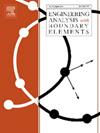Numerical analysis of basin response using Indirect Boundary Element Method (IBEM) for dip-slip sources
IF 4.2
2区 工程技术
Q1 ENGINEERING, MULTIDISCIPLINARY
Engineering Analysis with Boundary Elements
Pub Date : 2025-02-01
DOI:10.1016/j.enganabound.2024.106081
引用次数: 0
Abstract
Accurate modeling of basin structures and quantitative analysis of basin amplification effects are critical for seismologists and engineers. The Indirect Boundary Element Method (IBEM), developed from the Boundary Element Method (BEM), is particularly well-suited for these tasks due to its capability to manage layers with lateral inhomogeneities. However, current IBEM studies mostly focus on wavefields generated by plane wave incidence or point sources emitting pure spherical P or S waves, which often fail to capture the complex behavior of real seismic events. To address this limitation, we propose an updated IBEM scheme that simulates wavefields from dip-slip sources using the displacement-stress discontinuity vector. We validate this updated IBEM through degenerated models and sources, confirming its robustness in handling dip-slip sources. Further numerical tests reveal several features of basin amplification effects from dip-slip sources: (1) Sources with varying dips cause substantial differences in-basin peak numbers and amplitudes compared to simplified sources. For the surface responses, the ratio of maximum amplitudes (in-basin to out-of-basin) can exceed 10 with asymmetric distributed peaks. (2) The basin amplification effect for dip-slip sources shows similar frequency and velocity contrast dependencies compared to other simplified sources. Our study shows the IBEM scheme is effective and advantageous in basin amplification effect analysis, especially for different source configurations under the same model, with great potential for further applications for seismology, earthquake engineering, and hazard control.
倾斜滑源盆地响应的间接边界元法数值分析
盆地结构的精确建模和盆地放大效应的定量分析对地震学家和工程师来说至关重要。间接边界元法(IBEM)是从边界元法(BEM)发展而来的,由于其能够管理具有横向不均匀性的层,因此特别适合这些任务。然而,目前的 IBEM 研究大多集中于平面波入射或点源发射纯球形 P 波或 S 波产生的波场,往往无法捕捉真实地震事件的复杂行为。针对这一局限,我们提出了一种更新的 IBEM 方案,利用位移-应力不连续矢量模拟来自倾滑源的波场。我们通过退化模型和震源验证了这种更新的 IBEM,证实了它在处理倾滑震源时的稳健性。进一步的数值试验揭示了来自倾滑源的盆地放大效应的几个特征:(1) 与简化源相比,不同倾角的源会导致盆地峰值数量和振幅的巨大差异。就地表响应而言,非对称分布的峰值的最大振幅比(盆地内与盆地外)可超过 10。(2) 与其他简化源相比,倾滑源的盆地放大效应显示出类似的频率和速度对比依赖性。我们的研究表明,IBEM 方案在盆地放大效应分析中是有效和有优势的,特别是在同一模型下的不同震源配置中,在地震学、地震工程和灾害控制中具有巨大的进一步应用潜力。
本文章由计算机程序翻译,如有差异,请以英文原文为准。
求助全文
约1分钟内获得全文
求助全文
来源期刊

Engineering Analysis with Boundary Elements
工程技术-工程:综合
CiteScore
5.50
自引率
18.20%
发文量
368
审稿时长
56 days
期刊介绍:
This journal is specifically dedicated to the dissemination of the latest developments of new engineering analysis techniques using boundary elements and other mesh reduction methods.
Boundary element (BEM) and mesh reduction methods (MRM) are very active areas of research with the techniques being applied to solve increasingly complex problems. The journal stresses the importance of these applications as well as their computational aspects, reliability and robustness.
The main criteria for publication will be the originality of the work being reported, its potential usefulness and applications of the methods to new fields.
In addition to regular issues, the journal publishes a series of special issues dealing with specific areas of current research.
The journal has, for many years, provided a channel of communication between academics and industrial researchers working in mesh reduction methods
Fields Covered:
• Boundary Element Methods (BEM)
• Mesh Reduction Methods (MRM)
• Meshless Methods
• Integral Equations
• Applications of BEM/MRM in Engineering
• Numerical Methods related to BEM/MRM
• Computational Techniques
• Combination of Different Methods
• Advanced Formulations.
 求助内容:
求助内容: 应助结果提醒方式:
应助结果提醒方式:


